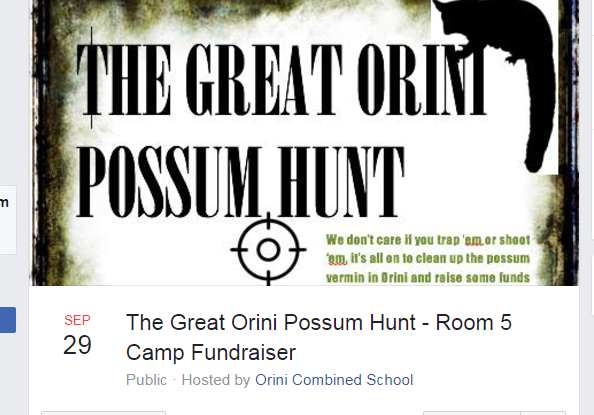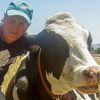Two very disturbing messages came into my email inbox last evening. When I saw the second one that also contained a message of hope, I was talking with someone about rampant animal abuse and they were surprised about the breadth of the arena of abuse highlighted by these two examples. Here, I simply want to write briefly about each of these two very different situations so that people can see the wide range of abuse, and also, if they choose, do something about it.
New Zealand’s war on wildlife
The first note I received centered on the on-going war against predators, including possums, in New Zealand. I’ve included the image the message contained, part of which reads, “We don’t care if you trap ‘em or shoot ‘em. it’s all on to clean up the possum vermin in Orini and raise some funds.” Note that this event is hosted by the Orini Combined School.

While many people still don’t know about New Zealand’s war on wildlife with the goal of getting rid of all predators by 2050, a good number of people do and are working hard to stop it as soon as they can. Background on this onslaught can be found in these essays and many links therein — “Youngsters Encouraged to Kill Possum Joeys in New Zealand,” “Long-Term Effects of Violence Toward Animals by Youngsters,” “Scapegoating Possums: Science, Psychology, and Words of War,” “Imprinting Kids for Violence Toward Animals,” and “Violence Toward Animals: ‘Can You Please Help My Daughter?’" Clearly, there’s a lot of work that needs to be done.
One part of this egregious war is to get youngsters to harm and to kill possums and other animals and to make it a family affair by their getting their parents and other adults to partake. Some people note there currently is a spate of killing sprees. They are horrific lessons in inhumane education. And, there is every reason to believe that these lessons and the call for abuse will have wide-ranging and long-term consequences. Violence can easily beget violence.
While there still is a lot of momentum and support for killing millions of animals in New Zealand, there also are people who are hard at work to stop this planned slaughter. They and the nonhuman animals need all the support they can get.
The abuse of animals in so-called “art”: Killing chickens and serving to them to the audience ... and an artists’s change in heart
The second note I received centered on an essay by Judy Carman titled “ART WITHOUT ANIMAL CRUELTY” (for more information about Ms. Carman please see Note 1). Ms. Carman’s essay is available online so here are a few snippets to whet your appetite for more. She begins, “It all started when ‘The Story of Chickens’ art project came to town. The artist’s plan was to display a group of chickens in a mobile pen for 30 days and then publicly kill them and serve them to her audience as a meal. As I struggled to understand how such an atrocity could be considered ‘art,’ I called city hall and learned, to my relief, that such activity was illegal within the city limits.”
Thank goodness there was a favorable ending to the potential massacre. Ms. Carman writes, “What happened next brought beautiful creativity into the process. Once she learned that her plan was illegal, the artist was quite open to our suggestions to use no live chickens at all and involve our animal rights group--Animal Outreach of Kansas (AOK)--in her work. She allowed us to display many works of art that were respectful of chickens in the month-long art display at the gallery. At the end of the month, she hosted a potluck at the gallery and allowed four of us to speak to the audience about the rights of chickens.” This change in heart was good for the chickens, and let’s hope it was a long-lasting educational lesson for the artist and many others.
What is “art?”
“It is safe to say that most of these works of art, if done by a non-artist, would be considered animal cruelty and possibly prosecuted.”
Ms. Carman goes on to write, “Still, a nagging question hung in the air-- how could the original art project ever have been considered ‘art’ and given a grant? And how could there be so many other animal abusing ‘art’ projects that have caused the suffering and deaths of so many sentient beings? A few examples include: the killing of a chicken in a school cafeteria as a filmed art project; setting fire to three live rats; the killing and displaying of 9,000 butterflies; throwing cats up a flight of stairs; the filming of a man holding a fish while he or she slowly died; and the strapping of LED lights to the legs of 2,000 pigeons and forcing them to fly at night, causing many to die.” She continues, “It is safe to say that most of these works of art, if done by a non-artist, would be considered animal cruelty and possibly prosecuted.”
Ms. Carman’s last sentence is a very important point to consider for it highlights how some forms of abuse are accepted by some people because they think they’re creative, despite being reprehensible. or approved by some governing body. I’ve always thought that projects that involve harming and killing animals fell way outside of the realm of art, and Ms. Carman’s essay surely will lead to many discussions on the question of “What is ‘art’?” I remember telling some people about some of the projects which Ms. Carman lists. One person thought I was joking — I wasn’t — and another asked, “Who are these sickies and how do they get away with this?”
Returning to the horrific situation in New Zealand, some people also accept animal abuse because it’s part of some sort of sanctioned master plan, as is the goal to rid the islands of pests by 2050. They think it’s okay because some authority figures say it is. One person who works on behalf of animals in New Zealand wrote, “The hate seems so widespread and ‘acceptable’…The Government propaganda has sadly convinced the vast majority of the NZ population. It will be a really tough nut to crack.” And it surely will be.
Of course, the animals themselves don’t really care if their pain and death are sanctioned or not. They suffer and die regardless of the intent of the abusers. And, people who care must do something about it.
Minding Animals and hope
Another aspect of Ms. Carman’s essay that’s worth noting is how important it is to have guidelines for what is and for what is not permissible in art exhibits (and other venues). Here, she notes, “Minding Animals International has just introduced a powerful new tool that will help us bring an end to using live animals in art. That tool is the Minding Animals Curatorial Guidelines. One of the goals of the Guidelines committee was ‘to identify and avoid human exceptionalism/anthropocentrism, which prioritises humans over animals.’” The main authors of the guidelines were Carol Gigliotti, Yvette Watt, Jessica Ulrich and Rod Bennison, and along with other board members of Minding Animals International, I was part of the on-going discussions about the guidelines that went through a good number of iterations.
We’re all thrilled to see the guidelines put to use in the real world. In addition to the artist changing her mind on the nature of her exhibit, the application of the Minding Animals Curatorial Guidelines also is a reason for hope. (The next Minding Animals conference will be from 17 to 24 January, 2018 in Ciudad de México.)
Cruelty can’t stand the spotlight: The importance of remaining positive
As Gretchen Wyler aptly said, “Cruelty can’t stand the spotlight.” While violence can beget violence, compassion can surely beget compassion. Media can play a huge role in exposing what is happening and spreading the word to a broad audience, many of whom may be uninformed about the abuse to which other animals are routinely subjected around the world.
Every individual can make a positive difference in the lives of other animals, and it’s good to know that those who work on behalf of nonhuman animals enjoy successes along the way. Kudos to the artist who changed her exhibit. It often takes a lot of hard work, but it’s well worth the effort in an increasingly human-dominated world. Nonhuman animals need all the help they can get, and focusing on what works is a good way to move into the future.
I hope that by bringing these two very different examples of animal abuse to light, people will learn about and get out and do something to stop rampant and global mistreatment that still knows no bounds. Unrelenting and violent animal abuse has to be met with unrelenting non-violent resistance and positive thinking.
Note 1: “Judy Carman is the author of the award winning Peace to All Beings: Veggie Soup for the Chicken’s Soul; and co-author with Tina Volpe of The Missing Peace. She is co-founder with Will and Madeleine Tuttle of Circle of Compassion and the Prayer Circle for Animals Facebook. A recipient of the Henry Spira Animal Activist Award, she founded the Animals’ Peace Prayer Flag Project; co-founded, with Lisa Levinson, the Interfaith Vegan Coalition; and co-founded Animal Outreach of Kansas.”
Marc Bekoff’s latest books are Jasper’s Story: Saving Moon Bears (with Jill Robinson); Ignoring Nature No More: The Case for Compassionate Conservation; Why Dogs Hump and Bees Get Depressed: The Fascinating Science of Animal Intelligence, Emotions, Friendship, and Conservation; Rewilding Our Hearts: Building Pathways of Compassion and Coexistence; The Jane Effect: Celebrating Jane Goodall (edited with Dale Peterson); and The Animals’ Agenda: Freedom, Compassion, and Coexistence in the Human Age (with Jessica Pierce). Canine Confidential: Why Dogs Do What They Do will be published in early 2018. Learn more at marcbekoff.com.
